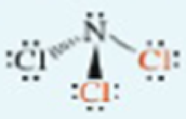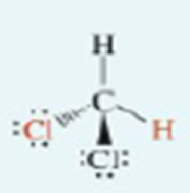
General, Organic, and Biological Chemistry (3rd Edition)
3rd Edition
ISBN: 9780134042428
Author: Laura D. Frost, S. Todd Deal
Publisher: PEARSON
expand_more
expand_more
format_list_bulleted
Textbook Question
Chapter 3, Problem 3.46PP
For the molecules shown, indicate whether the orange-colored atoms are in-front-of, behind, or in the plane of this book.


Expert Solution & Answer
Want to see the full answer?
Check out a sample textbook solution
Students have asked these similar questions
None
Draw a Newman projection from carbon 3 to carbon 2 in the highest energy
conformation for the following molecule. What is this conformation called? What kind of
strain is present?
Br
Which of the following dienophiles is most reactive in a Diels-Alder reaction:
Please explain why the correct answer to this question is option 5. Please provide a detailed explanation.
Chapter 3 Solutions
General, Organic, and Biological Chemistry (3rd Edition)
Ch. 3 - How many electrons are in each energy level of the...Ch. 3 - How many electrons are in each energy level of the...Ch. 3 - How many valence electrons are present in the...Ch. 3 - How many valence electrons are present in the...Ch. 3 - Which of the following elements are stable as...Ch. 3 - Which of the following elements are stable as...Ch. 3 - Prob. 3.7PPCh. 3 - Prob. 3.8PPCh. 3 - Prob. 3.9PPCh. 3 - How are the names of a transition metal atom and...
Ch. 3 - Provide the charge on each element when an ion is...Ch. 3 - Provide the charge on each element when an ion is...Ch. 3 - Prob. 3.13PPCh. 3 - How many protons and electrons are present in the...Ch. 3 - Name the ions in Problem 3.13.Ch. 3 - Prob. 3.16PPCh. 3 - Prob. 3.17PPCh. 3 - Give the name and symbol of the ion with the...Ch. 3 - Prob. 3.19PPCh. 3 - Name the following ions: a. Cu2+ b. SO42 c. HPO42Ch. 3 - Prob. 3.21PPCh. 3 - Prob. 3.22PPCh. 3 - Prob. 3.23PPCh. 3 - Prob. 3.24PPCh. 3 - Prob. 3.25PPCh. 3 - Prob. 3.26PPCh. 3 - Prob. 3.27PPCh. 3 - Prob. 3.28PPCh. 3 - Draw the correct Lewis structure for each of the...Ch. 3 - Draw the correct Lewis structure for each of the...Ch. 3 - Draw the correct Lewis structure for each of the...Ch. 3 - Draw the correct Lewis structure for each of the...Ch. 3 - Determine whether each of the following is a...Ch. 3 - Determine whether each of the following is a...Ch. 3 - Prob. 3.35PPCh. 3 - Prob. 3.36PPCh. 3 - Compare (a) the number of atoms and (b) the number...Ch. 3 - Compare (a) the number of atoms and (b) the number...Ch. 3 - Calculate the following: a. the number of Na atoms...Ch. 3 - Calculate the following: a. the number of S atoms...Ch. 3 - Prob. 3.41PPCh. 3 - Determine the molar mass for the following...Ch. 3 - Prob. 3.43PPCh. 3 - Prob. 3.44PPCh. 3 - For the molecules shown, indicate whether the...Ch. 3 - For the molecules shown, indicate whether the...Ch. 3 - For the molecules in 3.45, determine the shape...Ch. 3 - For the molecules in 3.46, determine the around...Ch. 3 - Prob. 3.49PPCh. 3 - Prob. 3.50PPCh. 3 - Prob. 3.51PPCh. 3 - For each of the following molecules, (1) draw the...Ch. 3 - Prob. 3.53APCh. 3 - Prob. 3.54APCh. 3 - Prob. 3.55APCh. 3 - How many valence electrons are present in the...Ch. 3 - Prob. 3.57APCh. 3 - Prob. 3.58APCh. 3 - Complete the following statements: a. An anion has...Ch. 3 - Prob. 3.60APCh. 3 - Prob. 3.61APCh. 3 - Prob. 3.62APCh. 3 - Prob. 3.63APCh. 3 - Prob. 3.64APCh. 3 - Prob. 3.65APCh. 3 - Prob. 3.66APCh. 3 - Each of the following ions is isoelectronic with a...Ch. 3 - Each of the following ions is isoelectronic with a...Ch. 3 - Prob. 3.69APCh. 3 - Prob. 3.70APCh. 3 - Give the formula for the ionic compound formed by...Ch. 3 - Prob. 3.72APCh. 3 - Prob. 3.73APCh. 3 - Give the formula for each of the following ionic...Ch. 3 - Name the following ionic compounds: a. Na2O b....Ch. 3 - Prob. 3.76APCh. 3 - Prob. 3.77APCh. 3 - Prob. 3.78APCh. 3 - Prob. 3.79APCh. 3 - Prob. 3.80APCh. 3 - Prob. 3.81APCh. 3 - Prob. 3.82APCh. 3 - Prob. 3.83APCh. 3 - Prob. 3.84APCh. 3 - Prob. 3.85APCh. 3 - Explain the difference between a Lewis structure...Ch. 3 - Draw a Lewis structure for each of the following...Ch. 3 - Draw a Lewis structure for each of the following...Ch. 3 - Prob. 3.89APCh. 3 - Give the name of each of the following covalent...Ch. 3 - Explain the difference between an ionic bond and a...Ch. 3 - What are the units of Avogadros number?Ch. 3 - Prob. 3.93APCh. 3 - Prob. 3.94APCh. 3 - What is the mass of 4.00 moles of the following?...Ch. 3 - How many atoms or molecules are in 5.0 moles of...Ch. 3 - A pencil mark (made with graphite, a form of...Ch. 3 - Prob. 3.98APCh. 3 - Prob. 3.99APCh. 3 - Prob. 3.100APCh. 3 - Aspartic acid, a naturally occurring amino acid...Ch. 3 - Cyanoacrylic acid is one of the compounds used to...Ch. 3 - Methyl isocyanate is used in the manufacturing of...Ch. 3 - Vinyl acetate is used in the production of safety...Ch. 3 - Identify the more electronegative atom in each of...Ch. 3 - Identify the more electronegative atom in each of...Ch. 3 - Prob. 3.107APCh. 3 - Prob. 3.108APCh. 3 - Prob. 3.109CPCh. 3 - Prob. 3.110CPCh. 3 - Prob. 3.111CPCh. 3 - Vinyl chloride, C2H3Cl, is used in the production...Ch. 3 - One of the most common compounds used in...Ch. 3 - Prob. 1IA.1QCh. 3 - Prob. 1IA.2QCh. 3 - Prob. 1IA.3QCh. 3 - Prob. 1IA.4QCh. 3 - Prob. 1IA.5QCh. 3 - Prob. 1IA.6QCh. 3 - Prob. 1IA.7QCh. 3 - Prob. 1IA.8QCh. 3 - Prob. 2IA.1QCh. 3 - Complete the following table: Molecular Formula...Ch. 3 - Complete the following table: Molecular Formula...Ch. 3 - Based on the tables in questions 2 and 3, does the...Ch. 3 - Prob. 3IA.1QCh. 3 - Prob. 3IA.2QCh. 3 - Draw the Lewis structure for ammonia. NH3. Show...Ch. 3 - Draw the Lewis structure for H2O. Show the...Ch. 3 - Draw the Lewis structure for carbon dioxide. What...Ch. 3 - Draw the Lewis structure for carbon tetrachloride,...Ch. 3 - Prob. 3IA.7QCh. 3 - Using a dipole moment arrow (), indicate the...Ch. 3 - Find out which cations and anions are important in...
Knowledge Booster
Learn more about
Need a deep-dive on the concept behind this application? Look no further. Learn more about this topic, chemistry and related others by exploring similar questions and additional content below.Similar questions
- Which of the following would you expect to be aromatic? Please provide a detailed explanation.arrow_forwardDraw the enantiomer and diastereomers of the following molecule. Label each type of stereoisomers. Label each chiral center as R or S. HOarrow_forwardWhich diene and dienophile would you choose to synthesize the following compound? Please provide a detailed explanation. Please include a drawing showing the mechanism of the synthesis. Please also explain why it is the correct diene and dienophile.arrow_forward
- Using the sketcher below, draw the structure of N-ethyldecylamine. Answer: 0 ୨୫) . 始 {n [ ]t ?arrow_forwardWhich of the following would you expect to be aromatic? Please provide a detailed explanation.arrow_forwardIdentify the characteristic signals that you would expect in the diagnostic region of an IR spectrum of each of the following compounds. a. H₂N b.arrow_forward
- What is the lowest energy chair for the following cyclohexane? ' || || a. b. " " d.arrow_forwardAnswer the following questions using the below figure: Potential Energy ри Reaction Progress a. How many transition states occur in this reaction? b. How many intermediates occur in this reaction? c. Is this reaction spontaneous or nonspontaneous? d. Does this reaction have a positive or negative AG? e. Label the activation energy(ies).arrow_forwardDraw the following molecule as a chair in the lowest energy conformation. Then perform a chair flip. Brarrow_forward
arrow_back_ios
SEE MORE QUESTIONS
arrow_forward_ios
Recommended textbooks for you
 Chemistry: The Molecular ScienceChemistryISBN:9781285199047Author:John W. Moore, Conrad L. StanitskiPublisher:Cengage Learning
Chemistry: The Molecular ScienceChemistryISBN:9781285199047Author:John W. Moore, Conrad L. StanitskiPublisher:Cengage Learning Introduction to General, Organic and BiochemistryChemistryISBN:9781285869759Author:Frederick A. Bettelheim, William H. Brown, Mary K. Campbell, Shawn O. Farrell, Omar TorresPublisher:Cengage Learning
Introduction to General, Organic and BiochemistryChemistryISBN:9781285869759Author:Frederick A. Bettelheim, William H. Brown, Mary K. Campbell, Shawn O. Farrell, Omar TorresPublisher:Cengage Learning Living By Chemistry: First Edition TextbookChemistryISBN:9781559539418Author:Angelica StacyPublisher:MAC HIGHER
Living By Chemistry: First Edition TextbookChemistryISBN:9781559539418Author:Angelica StacyPublisher:MAC HIGHER Chemical Principles in the LaboratoryChemistryISBN:9781305264434Author:Emil Slowinski, Wayne C. Wolsey, Robert RossiPublisher:Brooks ColeChemistry: Matter and ChangeChemistryISBN:9780078746376Author:Dinah Zike, Laurel Dingrando, Nicholas Hainen, Cheryl WistromPublisher:Glencoe/McGraw-Hill School Pub Co
Chemical Principles in the LaboratoryChemistryISBN:9781305264434Author:Emil Slowinski, Wayne C. Wolsey, Robert RossiPublisher:Brooks ColeChemistry: Matter and ChangeChemistryISBN:9780078746376Author:Dinah Zike, Laurel Dingrando, Nicholas Hainen, Cheryl WistromPublisher:Glencoe/McGraw-Hill School Pub Co World of Chemistry, 3rd editionChemistryISBN:9781133109655Author:Steven S. Zumdahl, Susan L. Zumdahl, Donald J. DeCostePublisher:Brooks / Cole / Cengage Learning
World of Chemistry, 3rd editionChemistryISBN:9781133109655Author:Steven S. Zumdahl, Susan L. Zumdahl, Donald J. DeCostePublisher:Brooks / Cole / Cengage Learning

Chemistry: The Molecular Science
Chemistry
ISBN:9781285199047
Author:John W. Moore, Conrad L. Stanitski
Publisher:Cengage Learning

Introduction to General, Organic and Biochemistry
Chemistry
ISBN:9781285869759
Author:Frederick A. Bettelheim, William H. Brown, Mary K. Campbell, Shawn O. Farrell, Omar Torres
Publisher:Cengage Learning

Living By Chemistry: First Edition Textbook
Chemistry
ISBN:9781559539418
Author:Angelica Stacy
Publisher:MAC HIGHER

Chemical Principles in the Laboratory
Chemistry
ISBN:9781305264434
Author:Emil Slowinski, Wayne C. Wolsey, Robert Rossi
Publisher:Brooks Cole

Chemistry: Matter and Change
Chemistry
ISBN:9780078746376
Author:Dinah Zike, Laurel Dingrando, Nicholas Hainen, Cheryl Wistrom
Publisher:Glencoe/McGraw-Hill School Pub Co

World of Chemistry, 3rd edition
Chemistry
ISBN:9781133109655
Author:Steven S. Zumdahl, Susan L. Zumdahl, Donald J. DeCoste
Publisher:Brooks / Cole / Cengage Learning
GCSE Chemistry - Differences Between Compounds, Molecules & Mixtures #3; Author: Cognito;https://www.youtube.com/watch?v=jBDr0mHyc5M;License: Standard YouTube License, CC-BY